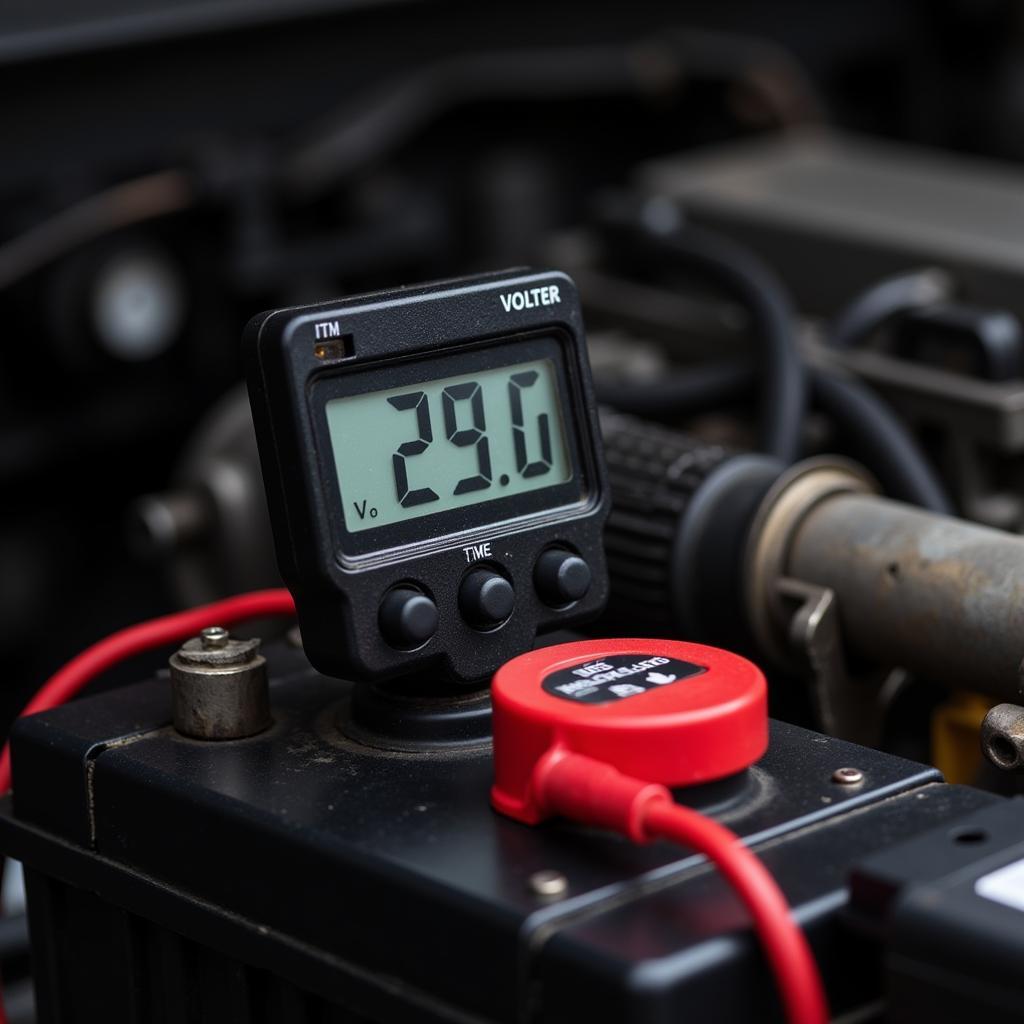Knowing how to check your car battery voltage is crucial for maintaining your vehicle’s health and avoiding unexpected breakdowns. A simple voltage check can reveal a wealth of information about your battery’s condition, potentially saving you time, money, and frustration down the road. This guide will equip you with the knowledge and tools necessary to check car battery voltage effectively.
A reliable car battery is essential for starting your engine, powering electrical components, and ensuring a smooth driving experience. But how do you know if your battery is up to par? The answer lies in understanding and regularly checking your car battery voltage. This seemingly small task can prevent unexpected starting issues and costly repairs. Want to know what essential tools every car owner should have? Check out our guide on car must have tools.
Understanding Car Battery Voltage
A fully charged car battery should typically register around 12.6 volts. However, this number can fluctuate based on factors like temperature and the battery’s age. A voltage reading significantly lower than 12.6 volts could indicate a problem, such as a failing battery, a faulty alternator, or a parasitic drain.
Why is Checking Voltage Important?
Regularly checking your battery voltage allows you to identify potential issues before they escalate. A failing battery can lead to starting problems, dimming headlights, and even complete electrical failure. By proactively monitoring your battery’s voltage, you can address these issues early on and avoid being stranded.
Tools to Check Car Battery Voltage
Several tools can effectively check your car battery voltage, each with its own advantages and disadvantages.
Multimeter
A multimeter is a versatile tool that can measure voltage, current, and resistance. It’s a valuable tool for any DIY enthusiast and provides accurate voltage readings. Digital multimeters are generally easier to read and more precise than their analog counterparts.
 Checking Car Battery Voltage with Digital Multimeter
Checking Car Battery Voltage with Digital Multimeter
Battery Tester
Battery testers are specifically designed for testing car batteries. They often provide more information than just voltage, such as cold cranking amps (CCA) and battery health. Some advanced testers can even diagnose charging system issues.
Voltmeter
A voltmeter is a simpler tool dedicated solely to measuring voltage. While not as versatile as a multimeter, it’s a cost-effective option for checking battery voltage. Analog voltmeters require a bit more interpretation than digital ones, but they can still provide valuable information.
 Voltmeter Measuring Car Battery Voltage
Voltmeter Measuring Car Battery Voltage
How to Check Car Battery Voltage with a Multimeter
Using a multimeter to check your battery voltage is a straightforward process:
- Set the multimeter to the DC voltage setting.
- Connect the red probe to the positive (+) terminal of the battery.
- Connect the black probe to the negative (-) terminal of the battery.
- Read the voltage displayed on the multimeter.
How to Interpret the Readings
- 12.6 volts or higher: Your battery is fully charged and in good condition.
- 12.4-12.5 volts: Your battery is slightly discharged but still functional.
- 12.2-12.3 volts: Your battery is moderately discharged and may need charging.
- 12.0 volts or lower: Your battery is significantly discharged and likely needs replacing.
“Regular battery checks are essential preventative maintenance,” says John Smith, Lead Automotive Technician at Chicago Auto Experts. “It’s a simple task that can prevent major headaches down the road.”
Maintaining Your Car Battery
Besides regular voltage checks, here are some tips to prolong your car battery’s lifespan:
- Clean the battery terminals regularly to prevent corrosion.
- Limit short trips, as they don’t allow the battery to fully recharge.
- Avoid leaving accessories on when the engine is off.
If you’re interested in learning more about useful car tools, our guide on car tools to have provides a comprehensive overview. For those intrigued by the world of RC cars, check out our article on tools needed to build an rc car.
“A well-maintained battery is crucial for reliable vehicle performance,” adds Jane Doe, Electrical Systems Specialist at AutoTech Solutions. “Don’t neglect this critical component.” If you’re a DIY enthusiast and looking to explore more car projects, check out our article on tools for life car. Or, if you’re interested in unconventional car modifications, have a look at our piece on cordless tool conversion for car horn.
Conclusion
Using a Tool To Check Car Battery Voltage is a simple yet vital aspect of car maintenance. By regularly monitoring your battery’s voltage, you can prevent unexpected breakdowns and extend its lifespan. Invest in a reliable tool and make voltage checks a part of your routine car care.
FAQ
- How often should I check my car battery voltage? Ideally, every month or two.
- Can I check the voltage with the engine running? Yes, but the reading will be higher due to the alternator charging the battery.
- What are cold cranking amps (CCA)? A measure of a battery’s ability to start an engine in cold temperatures.
- What causes a parasitic drain? An electrical component drawing power even when the car is off.
- How long does a car battery typically last? 3-5 years, depending on usage and maintenance.
- Should I disconnect the battery before checking the voltage? No, it’s not necessary for a simple voltage check.
- What other tools are helpful for car maintenance? Explore our resource on car tools to have for more insights.
Need help with car diagnostics? Contact us via WhatsApp: +1(641)206-8880, Email: [email protected] or visit us at 910 Cedar Lane, Chicago, IL 60605, USA. We offer 24/7 customer support.

Leave a Reply